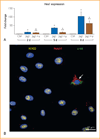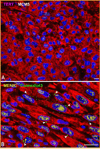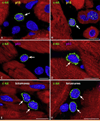Innate regeneration in the aging heart: healing from within
- PMID: 23910414
- PMCID: PMC3936323
- DOI: 10.1016/j.mayocp.2013.04.001
Innate regeneration in the aging heart: healing from within
Abstract
The concept of the heart as a terminally differentiated organ incapable of replacing damaged myocytes has been at the center of cardiovascular research and therapeutic development for the past 50 years. The progressive decline in myocyte number as a function of age and the formation of scarred tissue after myocardial infarction have been interpreted as irrefutable proofs of the postmitotic characteristic of the heart. However, emerging evidence supports a more dynamic view of the heart in which cell death and renewal are vital components of the remodeling process that governs cardiac homeostasis, aging, and disease. The identification of dividing myocytes in the adult and senescent heart raises the important question concerning the origin of these newly formed cells. In vitro and in vivo findings strongly suggest that replicating myocytes derive from lineage determination of resident primitive cells, supporting the notion that cardiomyogenesis is controlled by activation and differentiation of a stem cell compartment. It is the current view that the myocardium is an organ permissive of tissue regeneration mediated by exogenous and endogenous progenitor cells.
Keywords: CSC; EF; cardiac stem cell; ejection fraction; hCSC; human cardiac stem cell.
Copyright © 2013 Mayo Foundation for Medical Education and Research. Published by Elsevier Inc. All rights reserved.
Figures






Similar articles
-
Human heart failure: is cell therapy a valid option?Biochem Pharmacol. 2014 Mar 15;88(2):129-38. doi: 10.1016/j.bcp.2013.10.031. Epub 2013 Nov 13. Biochem Pharmacol. 2014. PMID: 24239645 Free PMC article. Review.
-
Myocyte turnover in the aging human heart.Circ Res. 2010 Nov 26;107(11):1374-86. doi: 10.1161/CIRCRESAHA.110.231498. Epub 2010 Nov 18. Circ Res. 2010. Retraction in: Circ Res. 2019 Feb 15;124(4):e23. doi: 10.1161/RES.0000000000000247. PMID: 21088285 Retracted.
-
Resident human cardiac stem cells: role in cardiac cellular homeostasis and potential for myocardial regeneration.Nat Clin Pract Cardiovasc Med. 2006 Mar;3 Suppl 1:S8-13. doi: 10.1038/ncpcardio0409. Nat Clin Pract Cardiovasc Med. 2006. PMID: 16501638 Review.
-
Myocyte death and renewal: modern concepts of cardiac cellular homeostasis.Nat Clin Pract Cardiovasc Med. 2007 Feb;4 Suppl 1:S52-9. doi: 10.1038/ncpcardio0773. Nat Clin Pract Cardiovasc Med. 2007. PMID: 17230216
-
The young mouse heart is composed of myocytes heterogeneous in age and function.Circ Res. 2007 Aug 17;101(4):387-99. doi: 10.1161/CIRCRESAHA.107.151449. Epub 2007 Jun 29. Circ Res. 2007. PMID: 17601802
Cited by
-
Up-Regulation of miRNA-21 Expression Promotes Migration and Proliferation of Sca-1+ Cardiac Stem Cells in Mice.Med Sci Monit. 2016 May 23;22:1724-32. doi: 10.12659/msm.895753. Med Sci Monit. 2016. PMID: 27210794 Free PMC article.
-
The Post-amyloid Era in Alzheimer's Disease: Trust Your Gut Feeling.Front Aging Neurosci. 2019 Jun 26;11:143. doi: 10.3389/fnagi.2019.00143. eCollection 2019. Front Aging Neurosci. 2019. PMID: 31297054 Free PMC article. Review.
-
How to Stimulate Myocardial Regeneration in Adult Mammalian Heart: Existing Views and New Approaches.Biomed Res Int. 2020 Mar 3;2020:7874109. doi: 10.1155/2020/7874109. eCollection 2020. Biomed Res Int. 2020. PMID: 32190680 Free PMC article. Review.
-
The role of the Wnt signaling pathway in cancer stem cells: prospects for drug development.Res Rep Biochem. 2014;4:1-12. doi: 10.2147/RRBC.S53823. Epub 2014 Jul 31. Res Rep Biochem. 2014. PMID: 26566491 Free PMC article.
-
Origin of cardiomyocytes in the adult heart.Circ Res. 2015 Jan 2;116(1):150-66. doi: 10.1161/CIRCRESAHA.116.303595. Circ Res. 2015. PMID: 25552694 Free PMC article. Review.
References
-
- Anversa P, Leri A, Kajstura J. Cardiac regeneration. J Am Coll Cardiol. 2006;47(9):1769–1776. - PubMed
-
- Murry CE, Field LJ, Menasché P. Cell-based cardiac repair: reflections at the 10-year point. Circulation. 2005;112(20):3174–3183. - PubMed
-
- Laflamme MA, Murry CE. Regenerating the heart. Nat Biotechnol. 2005;23(7):845–856. - PubMed
-
- Rubart M, Field LJ. Cardiac regeneration: repopulating the heart. Annu Rev Physiol. 2006;68:29–49. - PubMed
-
- Hansson EM, Lindsay ME, Chien KR. Regeneration next: toward heart stem cell therapeutics. Cell Stem Cell. 2009;5(4):364–377. - PubMed
MeSH terms
Grants and funding
- R01 AG017042/AG/NIA NIH HHS/United States
- P01 AG043353/AG/NIA NIH HHS/United States
- R01 HL114346/HL/NHLBI NIH HHS/United States
- P01 HL092868/HL/NHLBI NIH HHS/United States
- R01 HL039902/HL/NHLBI NIH HHS/United States
- R01 HL105532/HL/NHLBI NIH HHS/United States
- R01 AG037495/AG/NIA NIH HHS/United States
- R01 AG026107/AG/NIA NIH HHS/United States
- R01 HL065577/HL/NHLBI NIH HHS/United States
- P01 AG023071/AG/NIA NIH HHS/United States
- R37 HL081737/HL/NHLBI NIH HHS/United States
- R01 AG037490/AG/NIA NIH HHS/United States
- P01 HL078825/HL/NHLBI NIH HHS/United States
LinkOut - more resources
Full Text Sources
Other Literature Sources
Medical
Miscellaneous

